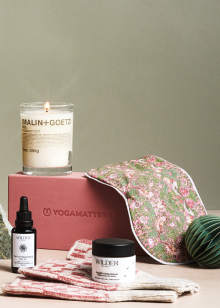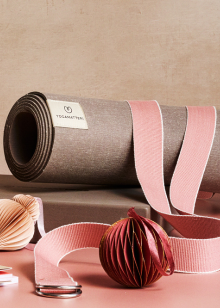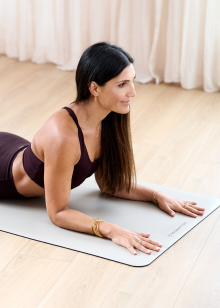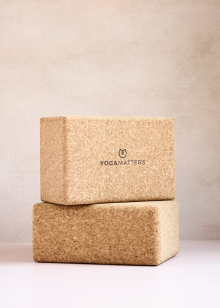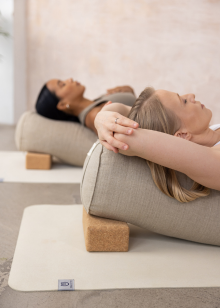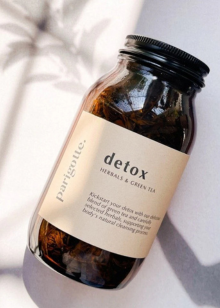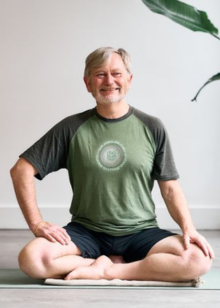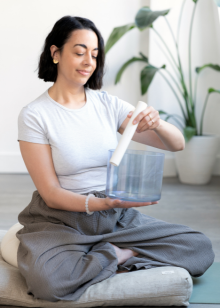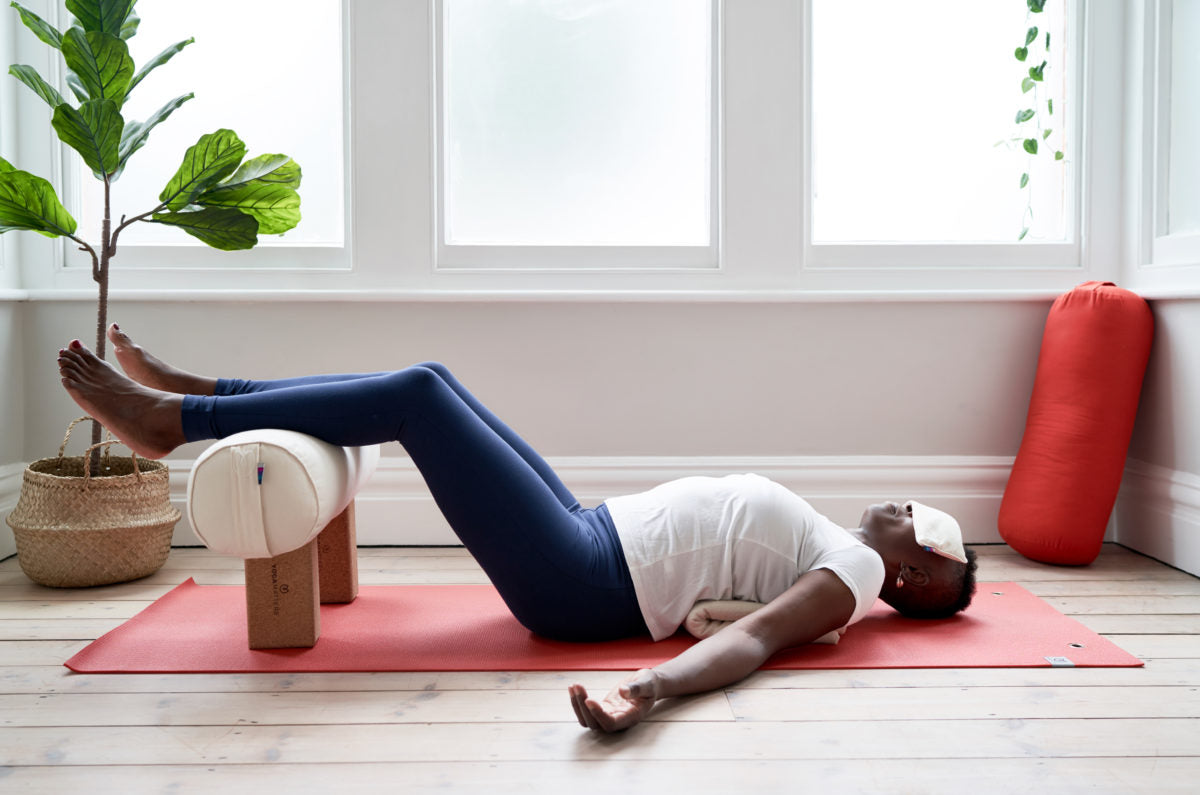Yoga nidra is yogic sleep, a state of consciousness between waking and sleeping.
It sounds simple, right? Not much to it.
There’s an art to Yoga nidra however. It’s a conscious relaxation practice providing deep restoration to body and mind. In a recent interview with Yogamatters, Sri Dharma Mittra describes Yoga nidra as ‘a guided form of active meditation’.
Yoga nidra allows us to move away from body consciousness, away from the thinking, analytical mind, to come to understand that what we are is so much more than either of them. Regular practice will help to establish us as a witness, watching the activities of the body and mind without becoming involved with either. The activities, the thoughts, everything we are currently passing through, is all a result of our deeds from the past and is for our soul’s education to make progress in self-realisation. As we come to see this more clearly, we can really rest, recharge and heal while in Shavasana, and this will help us in every other aspect of life. Sri Dharma Mittra
It certainly seems that there’s a lot more to Yoga nidra than first meets the eye. We asked three teachers who practise and teach Yoga nidra to unlock the secrets of Yoga nidra for us.
Linda Dixon has been teaching vinyasa flow yoga for 4 years and is also a qualified pregnancy yoga teacher. She’s about to start teaching yoga and mindfulness to infant and primary school aged children.
Paula Hines is a London-based yoga teacher with over 2000 hours of teaching experience, teaching Hatha, Flow, Restorative Yoga, Yin Yoga and Yoga nidra in a variety of settings.
Paula Turner describes herself as a dance artist, improviser, mover & shaker. She’s also a yoga teacher, offering ‘compassionate yoga that is for every body’.
How did you first discover Yoga nidra?
Paula Turner: I’m not actually sure…..like most things in life, there seem to be connections and winding paths that cross….aspects of Yoga nidra practice were familiar to me via other routes….. in the ‘traditions’ which make up my dance background, body scanning and the use of imagery to assist an increased awareness and progressive relaxation of body and mind have always formed part of practice.
Paula Hines: My first experience of Yoga nidra was at the end of a yoga class at my local gym, around sixteen years ago – it was a Hatha class I’d been attending once a week after work at a particularly stressful time. We were in Savasana and I was aware of the yoga teacher talking, but I didn’t know what Yoga nidra was. I had no idea what had just happened, but I felt an indescribable sense of calm afterwards. I was curious to learn more.
What do you love about Yoga nidra?
Linda Dixon: I love that it helps me relax! It helps me switch off, and quickly, and I always feel refreshed afterwards, not groggy like after a nap. I’m a parent to a toddler so resting when I can is very important to me.
Paula Turner: I love the way it sensitises you to sensation and is an invitation to practise ‘undoing’ and to witness that undoing as it happens….I experience it as an unpacking…..taking off layers until I arrive at the little gift…the essence of me, here now….breathing. It’s an incredibly spacious , expansive and freeing experience.
What makes Yoga nidra particularly relevant and necessary in our modern world?
Paula Hines: So many reasons – we know modern times are very turbulent. Chronic stress is an epidemic. There is over-stimulation, fear, depression, anxiety… the list is endless. How do we navigate our way through this world and all the challenges we are facing personally and on a global level? I don’t feel that any one thing can be a ‘cure-all’, but Yoga nidra, as an incredibly accessible and adaptogenic practice, can be a helpful tool for many of us. Its origins can be found in an ancient practice called nyasa, but emerging neuroscience and increasing studies are showing us what has been experienced since then – that Yoga nidra can have far-reaching benefits, from helping to minimise tension, calm the mind, find mental clarity, counteract stress, address past-traumas – there’s Richard Miller’s work with armed-forces veterans with PTSD, for example – and much more.
Linda Dixon: In today’s world, we have information overload in the palms of our hands – our phones – and we have connectivity to our devices 24-7. News, social media (including all its pressures), emails, work – the list goes on. Add in ‘world events’ – what’s happening where, when and to whom – it is harder and harder to switch off. Our nervous systems are pushed to the max. This is a ‘perfect storm’ for anxiety, sleep disorders and perhaps even mild depression. We can balance our nervous systems with Yoga nidra: constructive rest. No distractions. We can come into a place of personal peace and find our space within that peace as we practise. The more we practise, the more the body knows it’s possible to relax.
In Yoga nidra, you look like you’re doing nothing, but what work is actually going on?
Paula Hines: Though the word nidra means sleep, Yoga nidra is really a state, a practice of awareness – I like Richard Miller’s description of Yoga nidra being the realisation of our true nature, or true Self, and interconnectedness with all life. This is something easy to forget as we rush around in our day-to-day lives. During Yoga nidra, it is common to feel as though you have fallen asleep, but usually you are in a hypnogogic state (a state in-between sleep and being fully awake), so it is an altered state of consciousness – a Pratyahara state. In this effortless space of being, one can experience deep relaxation, a release of muscular tension and emotional stress, but this space also invites the possibility for self-inquiry, acceptance, emotional healing and more.
Linda Dixon: I always explain simply that when we are awake, our brain waves are up and when we sleep, our brainwaves are low and when we practise Yoga nidra, we aim for a place between wakefulness and sleep. The more scientific response would be to talk about brainwaves moving from beta – in our thinking mind, planning, remembering, maybe a little stressed or preoccupied – down to theta – the healing, intuitive, creative and relaxing space.
How do your students respond to Yoga nidra?
Linda Dixon: Almost always with a ‘I think I fell asleep but I could still hear you’. Sometimes people tell me they haven’t been able to relax like that for ages and occasionally people will share something very profound that happened while they were in deep relaxation which never ceases to amaze me. I teach Yoga nidra to pregnant ladies who normally come to class wanting to (or thinking they ‘should’ be able to) carry on as normal. After one or two yoga nidra sessions, they just get it and understand the importance of relaxation – for them and for baby.
Paula Turner: Everyone looks different at the end of a practice! I am sure someone with a skill for marketing could promote Yoga nidra as an anti-ageing treatment. Tension is released from faces, brows unfurrow and people just seem more open and released….not holding in or on to thoughts…There is a quality of softness, ease and openness and usually lots of smiling and a lot of silence lingers as people bring themselves around from a practice.
Students say they feel unburdened, delicious, tranquil, refreshed, zonked out, energised…..many report that they go on to have very deep sleep and lucid dreams that evening….
Well, we hope that you found those insights into Yoga nidra as helpful and inspiring as we did.
If you would like to practise Yoga nidra yourself, why not take a look at Paula Hines’ downloadable Yoga nidra sessions available online on ucanyoga.co.uk?
